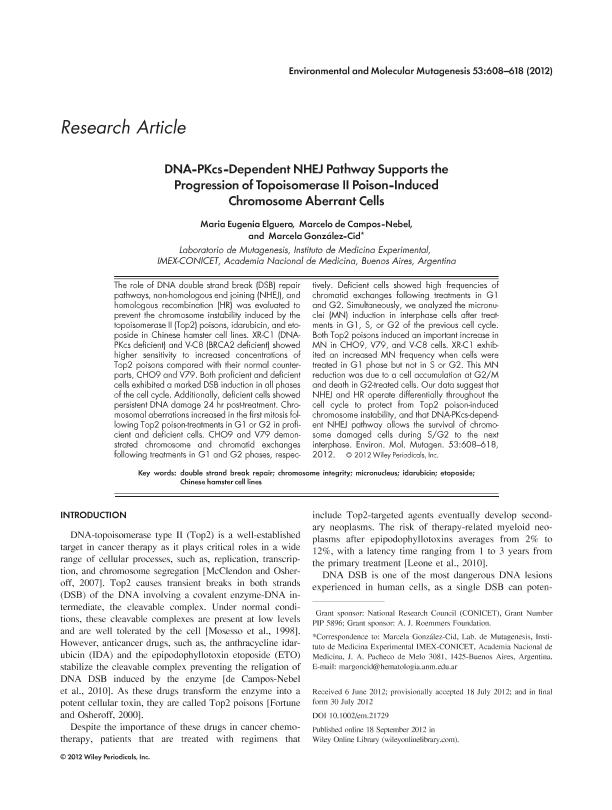Artículo
DNA-PKcs-dependent NHEJ pathway supports the progression of topoisomerase II poison-induced chromosome aberrant cells
Fecha de publicación:
10/2012
Editorial:
Wiley-liss, Div John Wiley & Sons Inc
Revista:
Environmental And Molecular Mutagenesis
ISSN:
0893-6692
Idioma:
Inglés
Tipo de recurso:
Artículo publicado
Clasificación temática:
Resumen
The role of DNA double strand break (DSB) repair pathways, non-homologous end joining (NHEJ), and homologous recombination (HR) was evaluated to prevent the chromosome instability induced by the topoisomerase II (Top2) poisons, idarubicin, and etoposide in Chinese hamster cell lines. XR-C1 (DNA-PKcs deficient) and V-C8 (BRCA2 deficient) showed higher sensitivity to increased concentrations of Top2 poisons compared with their normal counterparts, CHO9 and V79. Both proficient and deficient cells exhibited a marked DSB induction in all phases of the cell cycle. Additionally, deficient cells showed persistent DNA damage 24 hr post-treatment. Chromosomal aberrations increased in the first mitosis following Top2 poison-treatments in G1 or G2 in proficient and deficient cells. CHO9 and V79 demonstrated chromosome and chromatid exchanges following treatments in G1 and G2 phases, respectively. Deficient cells showed high frequencies of chromatid exchanges following treatments in G1 and G2. Simultaneously, we analyzed the micronuclei (MN) induction in interphase cells after treatments in G1, S, or G2 of the previous cell cycle. Both Top2 poisons induced an important increase in MN in CHO9, V79, and V-C8 cells. XR-C1 exhibited an increased MN frequency when cells were treated in G1 phase but not in S or G2. This MN reduction was due to a cell accumulation at G2/M and death in G2-treated cells. Our data suggest that NHEJ and HR operate differentially throughout the cell cycle to protect from Top2 poison-induced chromosome instability, and that DNA-PKcs-dependent NHEJ pathway allows the survival of chromosome damaged cells during S/G2 to the next interphase. © 2012 Wiley Periodicals, Inc.
Archivos asociados
Licencia
Identificadores
Colecciones
Articulos(IMEX)
Articulos de INST.DE MEDICINA EXPERIMENTAL
Articulos de INST.DE MEDICINA EXPERIMENTAL
Articulos(OCA HOUSSAY)
Articulos de OFICINA DE COORDINACION ADMINISTRATIVA HOUSSAY
Articulos de OFICINA DE COORDINACION ADMINISTRATIVA HOUSSAY
Citación
Elguero, María Eugenia; de Campos Nebel, Ildefonso Marcelo; Gonzalez Cid, Marcela Beatriz; DNA-PKcs-dependent NHEJ pathway supports the progression of topoisomerase II poison-induced chromosome aberrant cells; Wiley-liss, Div John Wiley & Sons Inc; Environmental And Molecular Mutagenesis; 53; 8; 10-2012; 608-618
Compartir
Altmétricas




